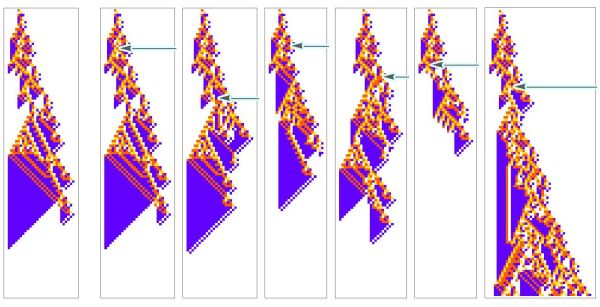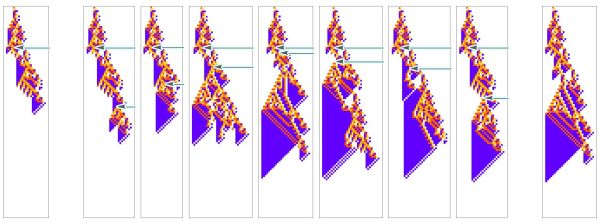Perturbed Cellular Automaton: Difference between revisions
No edit summary |
No edit summary |
||
| Line 1: | Line 1: | ||
A perturbed cellular automaton represents a cellular automaton, but with changes to any number of cells in its state, that are not specified by the rules. | A perturbed cellular automaton represents a cellular automaton, but with changes to any number of cells in its state, that are not specified by the rules. | ||
[[File:Pca.jpeg|350px|thumb|right| | [[File:Pca.jpeg|350px|thumb|right|Rule 30 with the red arrow indicating a perturbed cell that was changed from black to white, which results in a different pattern in the third row.]] | ||
In his research, Stephen Wolfram has used this system to model biological organisms surviving in uncertain environments, as well as the medical concepts of disease and treatment. | In his research, Stephen Wolfram has used this system to model biological organisms surviving in uncertain environments, as well as the medical concepts of disease and treatment. | ||
| Line 7: | Line 7: | ||
In these cases, the idea is that the unperturbed automata represents a "healthy organism", and a perturbation represents an unpredictable change in the environment. If the perturbation results in a change to some specific feature of the automata that is considered to be deleterious, say, making it "die out”, then we can think about that perturbation as causing a “disease”. | In these cases, the idea is that the unperturbed automata represents a "healthy organism", and a perturbation represents an unpredictable change in the environment. If the perturbation results in a change to some specific feature of the automata that is considered to be deleterious, say, making it "die out”, then we can think about that perturbation as causing a “disease”. | ||
[[File:Abstractfigure.jpeg|600px|thumb|center| | [[File:Abstractfigure.jpeg|600px|thumb|center| Perturbed cellular automata as a model for disease. In the first panel from the left, we show an unperturbed cellular automaton, our model for a “healthy organism”. In the subsequent panels, we show the resulting automata if we change one cell in the pattern, indicated by the light-blue arrow.]] | ||
In this framing we can begin to categorize the "types of disease": with some perturbations having little effect on the organism, other perturbations affecting the details of the pattern but keeping a similar overall shape, and some that disrupt both the "low-level" details and the "high-level" features. | In this framing we can begin to categorize the "types of disease": with some perturbations having little effect on the organism, other perturbations affecting the details of the pattern but keeping a similar overall shape, and some that disrupt both the "low-level" details and the "high-level" features. | ||
| Line 13: | Line 13: | ||
We can then imagine some secondary perturbation that is applied in an attempt to recover the original pattern, or “treat the organism”. | We can then imagine some secondary perturbation that is applied in an attempt to recover the original pattern, or “treat the organism”. | ||
[[File:Abstractfigure2.jpeg|600px|thumb|center| | [[File:Abstractfigure2.jpeg|600px|thumb|center| Perturbed cellular automata model as a model for medicine. In the first panel from the left, we show a perturbed cellular automaton, our model for a “diseased organism”. In the subsequent panels, we show the resulting automata if we make a second perturbation after the initial perturbation, in an attempt to recover the original automaton, which is shown first from the right. | ||
]] | |||
Revision as of 23:34, 15 April 2025
A perturbed cellular automaton represents a cellular automaton, but with changes to any number of cells in its state, that are not specified by the rules.

In his research, Stephen Wolfram has used this system to model biological organisms surviving in uncertain environments, as well as the medical concepts of disease and treatment.
In these cases, the idea is that the unperturbed automata represents a "healthy organism", and a perturbation represents an unpredictable change in the environment. If the perturbation results in a change to some specific feature of the automata that is considered to be deleterious, say, making it "die out”, then we can think about that perturbation as causing a “disease”.

In this framing we can begin to categorize the "types of disease": with some perturbations having little effect on the organism, other perturbations affecting the details of the pattern but keeping a similar overall shape, and some that disrupt both the "low-level" details and the "high-level" features.
We can then imagine some secondary perturbation that is applied in an attempt to recover the original pattern, or “treat the organism”.
